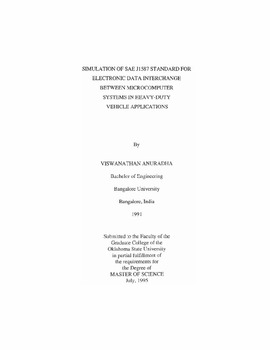| dc.description.abstract | The functionality of automotive systems has been improving with various additions such as real-time Electronic Control Units (ECDs) for engine management, anti-lock braking, and various other applications. Thus, customer expectations include the assurance that products will interface properly with one another and the ability to diagnose and troubleshoot electronic systems. In addition, components should protect themselves from damage, should provide self-diagnosis, perform efficiently and interface to standard service tools. A system must be properly designed and implemented to satisfy these growing demands. Two of the key factors in each design change are cost and performance. Currently, vehicles are designed to achieve both of these objectives. There haR heen an increase 1n the number of electronically controlled systems found in automobiles during the past several years. Until recently,. all electronic systems worked independently. The combined system performance can be optimized, without introducing the additional hardware burden for sensors and actuators, by constructing a serial communication network (often called multiplexing) [K1EN88]. The term 'multiplexing' as defined by the SAE Multiplexing and Data Communications subcommittee is a system transmitting several different messages on the same circuit or channel. In real-time systems, deadlines are critical and they must be met on time to prevent a catastrophe from happening due to delayed delivery of a message. Data transmission in a network is affected by the distribution of the traffic in the network. The data transmission is also subjected to timing delays due to the latency of messages in the network. Some of the other problems include messages that may be lost due to buffer saturation or corrupted by noise in the network. AU of these factors win further degrade the performance of the network. A major concern is the performance of such a network under heavy load. This means that as the message rate increases, the throughput and delay should remain stable. The scheduling of such messages is complex in a real-time system where deadlines must be met. An industry standard is required to ensure interoperability. On the basis that one protocol can meet the needs, there are many things to be gained by using a common standard including cornmon diagnostic tools and support, reduced component design engineering time, enhanced supplier support and innovation, enhance manufacturing, reduced complexity, and fluent evolution of future in-vehicle networks. | |
